Hoe, a 42-year old double upper limb amputee is a self-taught calligrapher who started practicing the art twenty years ago after an industrial accident in China severed her left arm and her right hand.
Hoe straps a calligraphy brush to her right arm stub and then, as she reports, uses her phantom hand to guide her strokes.
Hoe produces calligraphy by donation from a street stand in Malaka, Malaysia, supporting two daughters going to university in China with her earnings.
Even twenty years after her accident, Hoe experiences phantom limb pain, particularly in the remaining stub of her left arm. End The Pain Project has taken steps to relieve this pain through various methods, including Farabloc and an EMF band.
Hoe has great dignity and focuses on perfecting her calligraphy style. She hopes to inspire other amputees through her efforts.
Hoe explaining her calligraphy at her street stand in Melaka, Malaysia.
In February, 2012, Shannon Nill, an upper arm amputee from Oregon, displays the calligraphy created for him by Hoe in gratitude for an EMF band donated by Nill that helps her sleep. Nill uses the EMF band for sounder sleep as well.




























